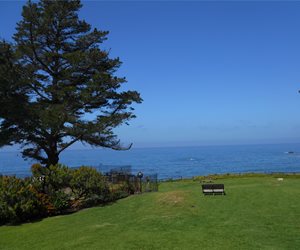Lawns for Sun and Shade
The best grasses for cool-season and warm-season conditionsFor sunny areas where winter dormancy is acceptable, the best lawns are warm-season turf varieties like Bermuda, hybrid Bermuda, kikuyu and zoysias. These trailing grasses are excellent at filling in bare spots and recover quickly from foot traffic. They also are very salt tolerant and do not burn easily from pet urine (high in salts and nitrogen). Warm-season grasses are also deep rooting and drought-tolerant. These types of lawns that go dormant are also best for cold climate areas and can typically handle being snowbound. On the downside, because these grasses trail, plan on a little extra work every couple of years to "de-thatch" and keep your lawn well groomed.
For sunny areas where year-round green is a must, consider hardy grasses like tall fescues and dwarf tall fescues. These types of grasses are referred to as "cool-season" grasses and stay green year-round in temperate climates. They will die or go severely dormant in snowbound communities. Fescue grass varieties are primarily "clump" grasses and while they do "tiller" (spread wider), they do not actually trail. As such, they are appropriate for low to medium foot traffic. Fescues' nontrailing growth habit can often make maintenance easier because these lawns stay in the space for which they were intended and do not invade adjacent planters. Fescues are deep rooting and drought tolerant, but not salt tolerant, so dog urine can burn spots. This is an important consideration if you share your yard with a pet. Fortunately, these unsightly spots are easy to seed and repair.
For shady areas, bluegrass (often called Kentucky Bluegrass) is a cool-season variety that has a higher shade tolerance than fescue. Bluegrass blends (over 100 cultivars are available) have a softer, finer blade and grow easily from seed or sod. This grass can actually fill in bare spots more quickly because it spreads by rhizomes (a horizontal underground stem that sends out its own roots and shoots) and tillers to create a dense sod lawn. A warm-season grass with a high shade tolerance is St. Augustine. This runner-type grass does well in both sunny and shaded areas.

 Backyards
Backyards
 Front Yards
Front Yards



